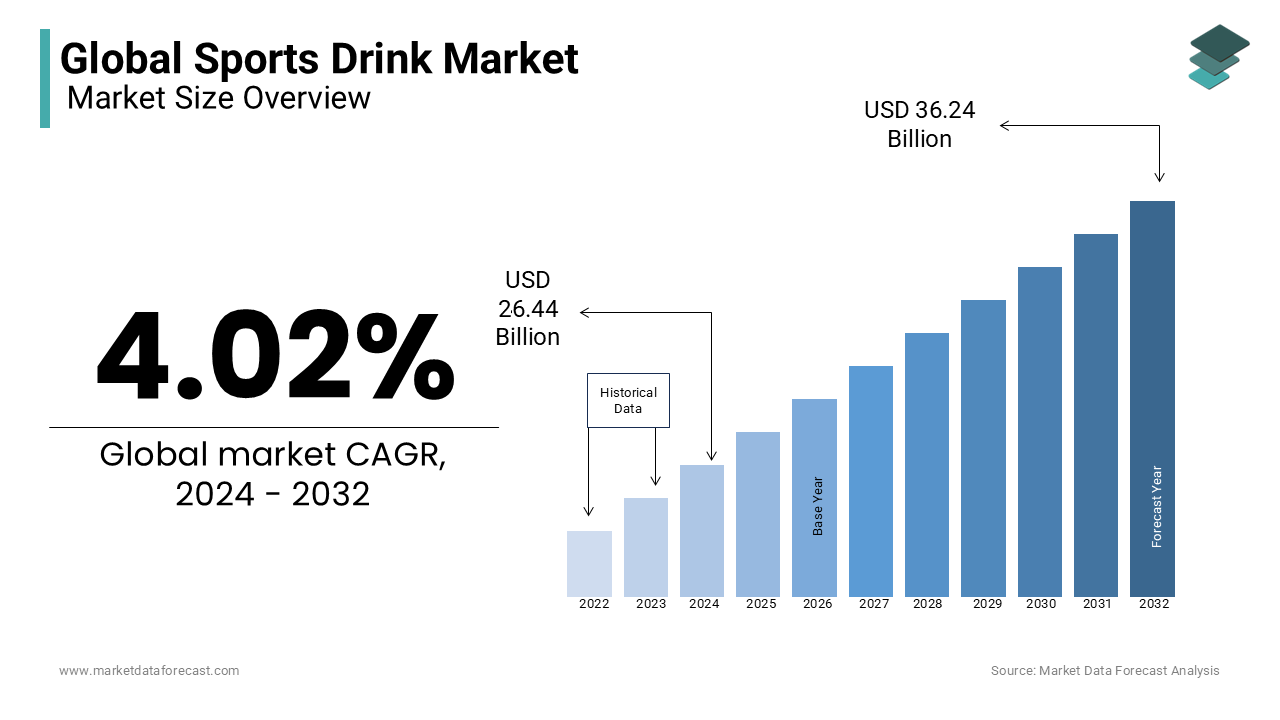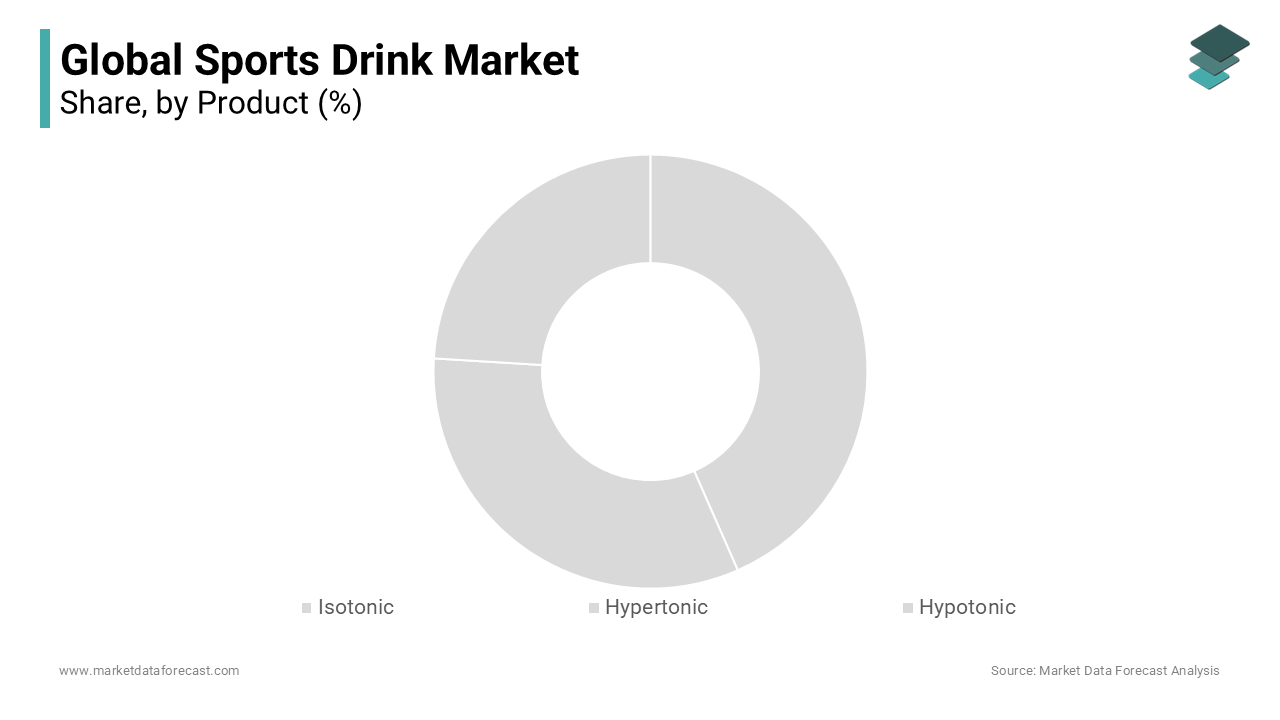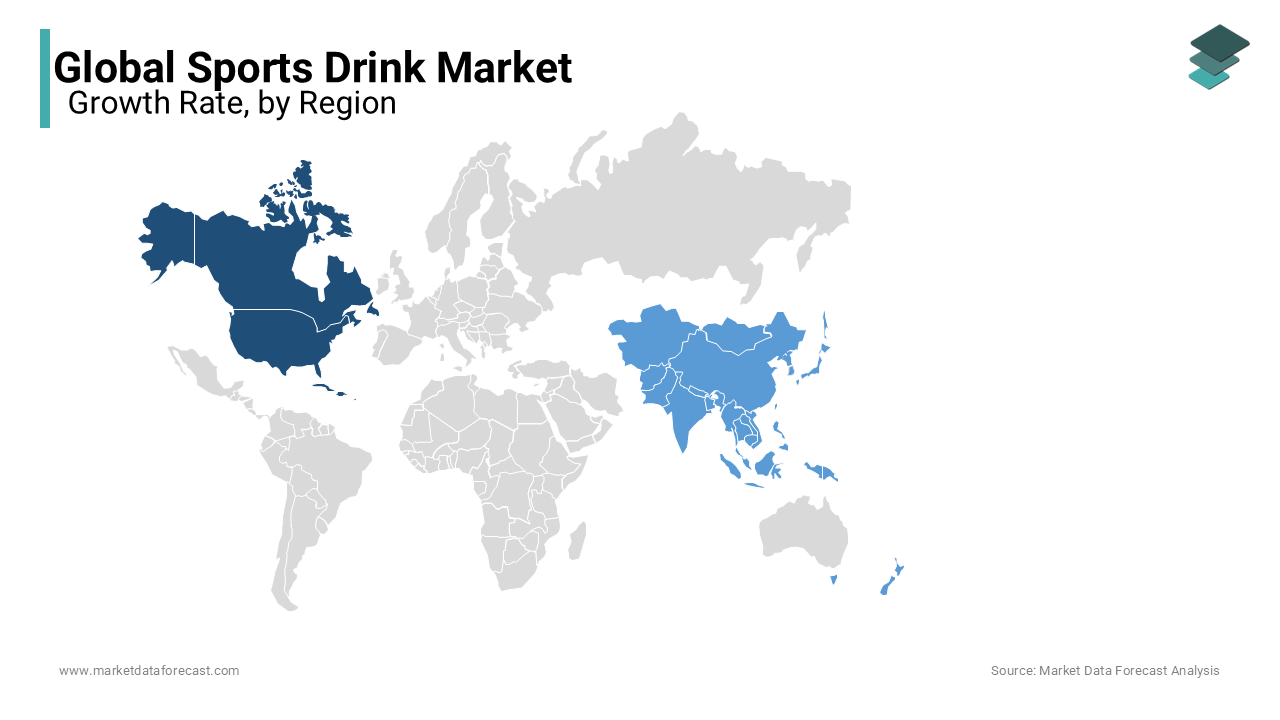Global Sports Drink Market Size, Share, Trends & Growth Forecast Report – Segmented By Product (Isotonic, Hypertonic and Hypotonic), Distribution Channel (Retail & Supermarkets and Online Platform), And Region (North America, Europe, Asia Pacific, Latin America, and Middle East & Africa) - Industry Analysis (2025 to 2033)
Global Sports Drink Market Size
The global sports drink market size was valued at USD 26.44 billion in 2024. The global market size is estimated to grow at a CAGR of 4.02% from 2025 to 2033 and be worth USD 37.69 billion by 2033 from USD 27.50 billion in 2025.

Water has consistently been the primary ingredient in sports drinks. Be that as it may, sports drinks additionally accompany different substances, for example, electrolytes and carbs. These ingredients are foreseen to better one's presentation, which is the reason they are getting to expand well-known. A portion of the critical factors that are relied upon to drive the market is the development of new flavors with included medical advantages and changing the way of life of customers, i.e., enlistment in the wellness and gyms, and eating appropriate supplement food, which gives them a proper supplement diet. Refreshment organizations in the Asia-Pacific area are focusing on expanding the interest for their sports drink portions with the assistance of different supports through well-known competitors and VIPs, limited-time crusades pervade, and occasions, among others.
MARKET DRIVERS
The growing demand for functional beverages in developed countries is propelling the sports drink market growth.
The market for functional beverages is expanding at a quick rate as purchasers are giving more consideration to remaining healthy. In the developed markets, drinks are never again seen exclusively as a brisk refreshment. They have become progressively helpful supplements and food supplement items. The locale is firmly affected by the buyer's center around protein, health, standards, and 'liberated from' trends. The purchaser sections driving the development of the market incorporate maturing buyers searching for essentialness, twenty to thirty-year-olds who are eager to attempt new items with well-being benefits, and occupied buyers looking for 'snappy well-being.'
The rising populace of competitors, sportspersons, and the expanding number of players in developing countries is further boosting the growth of the sports drink market.
What's more, there are expanding concerns among shoppers viewing its advantages; for example, it limits the danger of parchedness, and electrolytes in the sports drink additionally assist with supplanting the sweat and keeping up the equalization of electrolytes in the body. Expanding rivalry in sports, popularity preparation, and practice are powering the interest of the global sports drink market. Utilization of a sports beverage helps the competitors and sportspersons to keep up nourishing parity in their bodies and upgrade their exhibition. This additionally prompts expanding interest in sports drinks containing nutrients, minerals, and protein.
MARKET RESTRAINTS
The most prominent restraint of the global sports drink market is the dissent against the sugar content in the item. A solitary Monster drink can be assessed to have 14 teaspoons of sugar, a measurement that conflicts with the rulebook followed by the health industry. Like other refreshment combinations, caffeinated drinks organizations have likewise thought of without sugar or diet adaptations of the beverages to help up their deals, and not let the market observe a negative development.
REPORT COVERAGE
|
REPORT METRIC |
DETAILS |
|
Market Size Available |
2024 to 2033 |
|
Base Year |
2024 |
|
Forecast Period |
2025 to 2033 |
|
CAGR |
4.02% |
|
Segments Covered |
By Product, Distribution Channel and Region |
|
Various Analyses Covered |
Global, Regional & Country Level Analysis, Segment-Level Analysis, DROC, PESTLE Analysis, Porter’s Five Forces Analysis, Competitive Landscape, Analyst Overview of Investment Opportunities |
|
Regions Covered |
North America, Europe, APAC, Latin America, Middle East & Africa |
|
Market Leaders Profiled |
PepsiCo Inc, Coca-Cola Company, AJE Group, BodyArmor, Arizona Beverage Company, Gatorade Company, J Donohoe Beverages Ltd, BA Sports Nutrition, LLC, GU Energy Labs, BE Innovations, CytoSport, Inc and Others. |
SEGMENTAL ANALYSIS
Global Sports Drink Market Analysis By Product

They are termed based on the concentration of the drinks compared to the human body. Isotonic beverages contain an almost similar amount of sugar and salts in the human body, while hypertonic and hypotonic contain higher concentrations and lower concentrations, respectively. The isotonic product segment held the most substantial market share in 2023 and is expected to expand at a healthy CAGR over the projection period. The hypertonic product type is likely to grow at the highest CAGR of 4.6% over the forecast period.
Global Sports Drink Market Analysis By Distribution Channel
The growth of the retail sector, including supermarkets and hypermarkets, in addition to growing online shopping and a booming food and beverage industry, is supposed to impact the market growth positively.
REGIONAL ANALYSIS

In 2023, the North American sports drinks market held the largest share of about 40% in terms of revenue. The growth in this regional market is owing to the growing trend of athleticism and rising concerns over health. The recent changes in consumer lifestyle have resulted in the need for a healthy diet, which is likely to augment the business growth in this area. The sports drinks market is a way of life-driven market. The expanding worries about physical prosperity and driving a reliable way of life is a significant development drivers for the sports drink market. North America remains on top of provincial deals followed by Europe. Be that as it may, the expanding wellness pattern is finding different areas and driving deal numbers for the market.
The Asia-Pacific sports drink market is relied upon to flood, inferable from an expanding level of urbanization and development in the quantity of health focuses over the nations, similar to India and China. The ascending user interest in nutritious beverages is supposed to expand the sports drink market in the Asia Pacific, along with the use of no or fewer calories in the sugars utilized in the fitting of the sports drink by the producers in the national market.
KEY PLAYERS IN THE GLOBAL SPORTS DRINK MARKET
Companies that play a significant role in the global sports drink market include PepsiCo Inc, Coca-Cola Company, AJE Group, BodyArmor, Arizona Beverage Company, Gatorade Company, J Donohoe Beverages Ltd, BA Sports Nutrition, LLC, GU Energy Labs, BE Innovations, CytoSport, Inc and Others. The global sports drink market is relatively competitive compared to other sectors. PepsiCo Inc. and the Coca-Cola Company are among the prominent companies in the industry. The key players in this market are implementing several growth strategies like product launches, expansions, innovations, and others to retain their position in this competitive market. These companies have been introducing several remarkable products with natural ingredients and additives to improve their product reach to consumers among the existing products.
RECENT HAPPENINGS IN THE MARKET
- Coca-Cola refreshments organization has reported the presentation of its sports-to-drink Powerade, which is touted to give savage rivalry to PepsiCo's Gatorade. This dispatch denotes the company's coming into the sports drinks market, even as the organization hopes to expand its portfolio to give more decisions to clients who are picking health drinks far beyond improved carbonated beverages.
- Natural Recovery, situated in Columbus, Ohio, has a namesake non-carbonated, which is an exceptionally oxygenated refreshment line that represents 2.5 times the electrolytes of driving games drinks, according to the organization.
DETAILED SEGMENTATION OF THE GLOBAL SPORTS DRINK MARKET INCLUDED IN THIS REPORT
This research report on the global sports drink market has been segmented and sub-segmented based on product, distribution channel and region.
By Product
- Isotonic
- Hypertonic
- Hypotonic
By Distribution Channel
- Retail and Supermarkets
- Online Platforms
By Region
- North America
- The United States
- Canada
- Europe
- United Kingdom
- Spain
- Germany
- Italy
- France
- The Asia Pacific
- India
- Japan
- China
- Australia
- Singapore
- Malaysia
- South Korea
- New Zealand
- Southeast Asia
- Latin America
- Brazil
- Argentina
- Mexico
- Rest Of LATAM
- The Middle East and Africa
- Saudi Arabia
- UAE
- Lebanon
- Jordan
- Cyprus
Frequently Asked Questions
1. What are the major elements that drive the Sports Drink Market?
The market is being driven by a growing athlete community and an increase in the number of athletes in emerging countries.
2. What are the possibilities for sports drink demand in the future?
In 2021, North America had the largest share in the sports beverage market.
Related Reports
Access the study in MULTIPLE FORMATS
Purchase options starting from
$ 2500
Didn’t find what you’re looking for?
TALK TO OUR ANALYST TEAM
Need something within your budget?
NO WORRIES! WE GOT YOU COVERED!
Call us on: +1 888 702 9696 (U.S Toll Free)
Write to us: sales@marketdataforecast.com